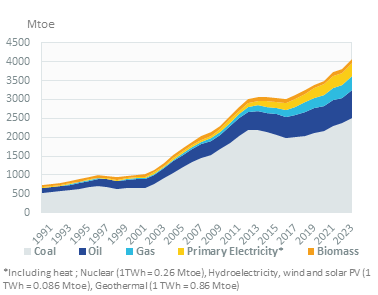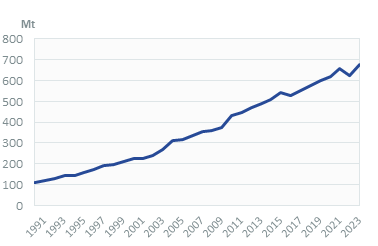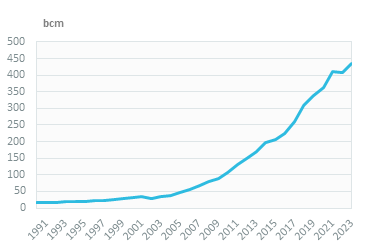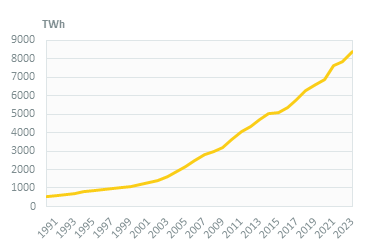-
-
 Energy and Climate Databases
Energy and Climate Databases- The most comprehensive and up-to-date annual energy database.
- Monitoring of technology providers in H2 supply chain.
- Monthly energy data on key energy markets.
- The most reliable and up-to-date power generation database.
- The essentials of LNG trade at your fingertips.
- Global monitoring of new and existing refineries.
- Analyse energy consumption and efficiency trends at world level. Benchmark countries.
- Have your database developed by a recognised expert of both energy and IT.
-
 Energy - Climate Forecasts
Energy - Climate Forecasts- Instant access to energy and emissions forecasts.
- Strategic, annual wholesale price projections backed by Enerdata's energy modelling expertise and our globally recognised POLES model.
- Wedges module showing a breakdown of the levers enabling to reduce emissions between two scenarios.
- Unique, independent projections of consumption by end-use.
- GHG Marginal Abatement Cost Curves.
- Benefit from proven models to draw your own energy scenarios and anticipate tomorrow’s challenges.
-
 Market Intelligence
Market Intelligence- 110 Energy and climate country reports
- A newsletter to receive the latest updates on evolving technologies and policies.
- Global energy news and analyses curated daily.
- Enerdata’s experts bring you the essentials about your market and competitors.
-
-
-
 Market Analysis
Market Analysis- Understanding key consumption trends and drivers across sectors.
- Granular and exclusive insight to address the most pressing business and strategic issues.
- Expertise in strategic and business intelligence, with fine-tuning to the market’s specificities.
-
 Energy - Climate Scenarios
Energy - Climate Scenarios- Providing the outlook of an energy commodity in mid to long term time horizons.
- Sector and driver specific energy demand forecasting.
- Assess the evolution of energy prices on the international and regional markets, as well as end-users prices.
- Enerdata guides you through pathways to reach climate targets.
- Supporting local authorities in their decarbonisation strategies.
-
 Climate Strategy and Policy Evaluation
Climate Strategy and Policy Evaluation- Cutting-edge quantitative tools and relevant indicators to monitor and evaluate evolutions on worldwide energy markets.
- Analysis of the most cost-effective options to reduce emissions.
- Quantified simulation and analysis of pledges for climate change negotiations.
- Breakdown and analysis of carbon markets.
- Enerdata guides you on the most beneficial policy or investment options.
- Turning climate objectives into concrete action plans.
-
 Training
Training- Understand different policy targets and measures on energy efficiency.
- How to measure energy savings?
- Energy Forecasting is a 2 days training to learn to design and interpret energy forecasts.
- Energy statistics training allowing to create energy balance with supply, transformation and consumption and understanding the international energy statistics regulations.
- Initiation to EnerMED level 1is the training to approach on the most powerful energy demand forecasting model.
-
-
Resource Centre
China Key Figures
- Population:
- 1412 million
- GDP growth rate:
- 5.01 %/year
- Energy independence:
- 78.6%
Data of the last year available: 2023
- Total consumption/GDP:*
- 61.4 (2005=100)
- CO2 Emissions:
- 9.12 tCO2/capita
- Rate of T&D power losses:
- 4.12%
* at purchasing power parity
View all macro and energy indicators in the China energy report
China Related News
View all news, archive your new and create your own daily newsletters only on your topics/countries of interest with Key Energy Intelligence
China Related Research
Benefit from up to 2 000 up-to-date data series for 186 countries in Global Energy & CO2 data
A data overview is available in the global energy statistics app
Total Energy Consumption
Total energy consumption per capita is increasing regularly, reaching 2.9 toe/cap in 2023 (nearly 4 times that for India). Electricity consumption per capita increased by nearly 7% to 5 944 kWh in 2023, more than twice the 2010 levels.
Graph: CONSUMPTION TRENDS BY ENERGY SOURCE (Mtoe)

Interactive Chart China Total Energy Consumption
Benefit from up to 2 000 up-to-date data series for 186 countries in Global Energy & CO2 data
View the detailed fondamentals of the market at country level (graphs, tables, analysis) in the China energy report
Crude Oil Production
Oil production has been increasing since 2019 (+1.8%/year), reaching 209 Mt in 2023. It declined by 3%/year between 2015 and 2018, after increasing by 2%/year between 2000 and 2015. Most of the production is onshore and located in the fields close to the north-eastern coast. Offshore production is in full development, with the Bohai basin being one of the most active areas.
Interactive Chart China Crude Oil Production
Benefit from up to 2 000 up-to-date data series for 186 countries in Global Energy & CO2 data
Additionally, for more detailed information on refineries, you can request a sample of our Asia Refineries Dataset
Oil Products Consumption
The consumption of oil products increased by 8% in 2023 to reach 677 Mt. Previously, it increased rapidly between 2010 and 2021 (+4%/year on average) but dropped by 5% in 2022.
In 2023, the share of the transport sector increased to 50%; the second largest energy consuming sector is industry (including non-energy uses) with around 33%.
Graph: OIL CONSUMPTION (Mt)

Graph: OIL CONSUMPTION BREAKDOWN BY SECTOR (2023, %)
Interactive Chart China Refined Oil Products Production
Benefit from up to 2 000 up-to-date data series for 186 countries in Global Energy & CO2 data
Additionally, for more detailed information on refineries, you can request a sample of our Asia Refineries Dataset
Natural Gas Consumption
Natural gas consumption rose by 7% in 2023 to 436 bcm, after decreasing slightly in 2022. In 2021, it grew by 12%, which was in line with the 2010-2019 trend. Despite the effects of the pandemic, gas consumption grew by 6% in 2020.
Industry represented 40% of gas demand in 2023, followed by the residential and services sector (18%), the power sector (18%), and transport (9%).
Graph: NATURAL GAS CONSUMPTION (bcm)

Interactive Chart China Natural Gas Domestic Consumption
Benefit from up to 2 000 up-to-date data series for 186 countries in Global Energy & CO2 data
Additionally, for more detailed information on the LNG trade, you can request a sample of our Asia LNG Trade Dataset
Coal Consumption
Coal and lignite consumption has been growing rapidly since 2021 (7/year), reaching nearly 5 Gt in 2023, after moderate growth between 2017 and 2020 (1%/year) and a decrease from 2014 to 2016 (-1.9%/year). It increased very rapidly between 2000 and 2013 (+9%/year).
The power sector is the largest user of coal and lignite in 2022, with 62%, followed by industry (15%). The share of the power sector has been increasing continually (45% in 2000 and 49% in 2010).
Graph: COAL CONSUMPTION (Mt)
Interactive Chart China Coal and Lignite Domestic Consumption
Benefit from up to 2 000 up-to-date data series for 186 countries in Global Energy & CO2 data
View the detailed consumption trends at country level (graphs, tables, analysis) in the China energy report
Power Consumption
Electricity consumption rose by 7% in 2023 to 8 392 TWh, back to its growth over 2010-2021, after a 4% increase in 2022 and a 10% jump in 2021.
Industry is the main consumer (58% in 2023), followed by residential and services (17% and 16%, respectively).
Graph: ELECTRICITY CONSUMPTION (TWh)

Graph: ELECTRICITY CONSUMPTION BREAKDOWN BY SECTOR (2023,%)
Renewable in % Electricity Production
With the 14th FYP, the country intends to get 20% of its total energy consumption from non-fossil fuels in 2025 (11% in 2023). The target of 15% of renewables in total energy consumption in 2020 was not reached (only 10%) ("Guiding Opinions on Establishing Renewable Energy Portfolio Standards", NEA, 2016). In 2018, the NDRC also set a target of a 9% share of non-hydro renewables in electricity consumption for 2020 and 35% in 2030 (15% reached in 2023).
Interactive Chart China Share of Renewables in Electricity Production (incl hydro)
Benefit from up to 2 000 up-to-date data series for 186 countries in Global Energy & CO2 data
Learn more about renewables in the Mini grid Africa & Asia markets for village electrification
CO2 Fuel Combustion/CO2 Emissions
In its updated NDC (2021), China set more ambitious targets for 2030: reaching a CO2 emission peak before 2030, lowering its CO2 intensity by over 65% (from 2005 levels), and eventually reaching carbon neutrality before 2060. It aims to cut the average coal consumption rate in power plants to 300g/kWh between 2020 and 2025.